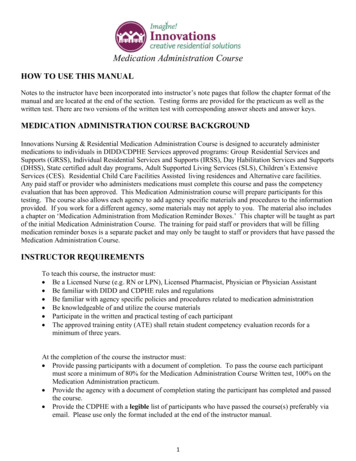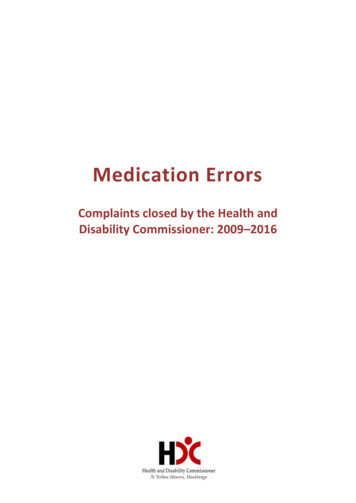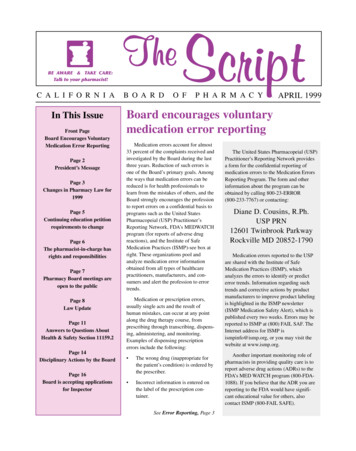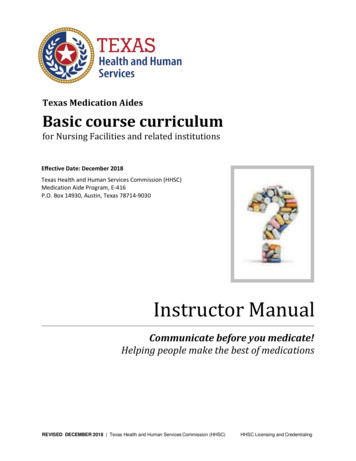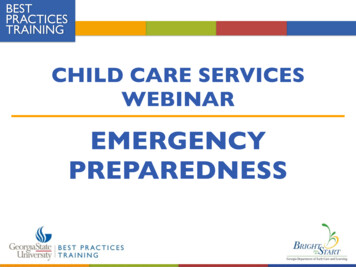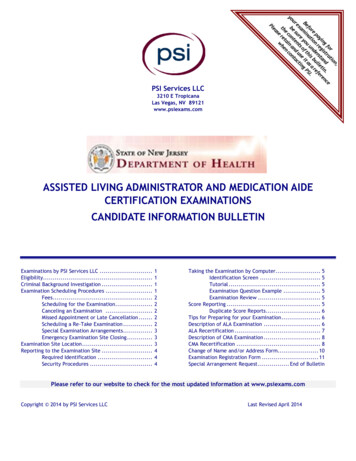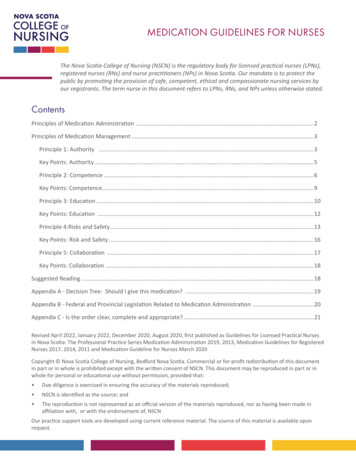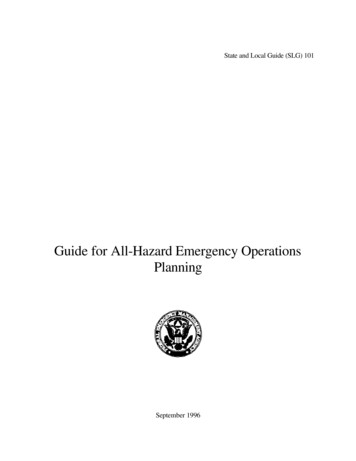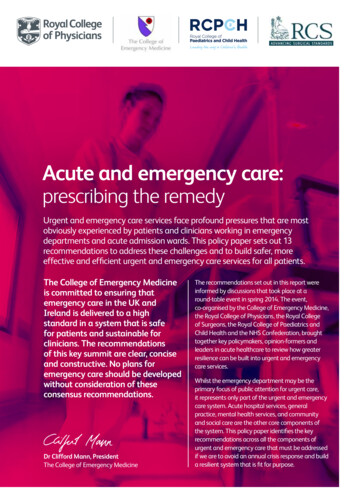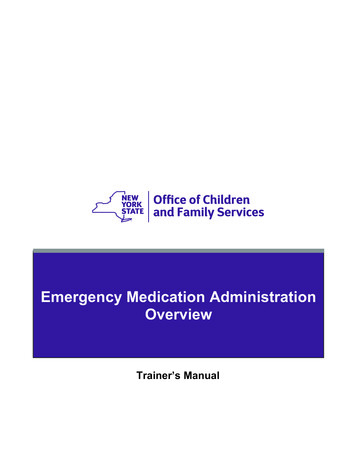
Transcription
Emergency Medication AdministrationOverviewTrainer’s Manual
This document is provided under a contractual agreement between theNew York State Office of Children and Family ServicesDivision of AdministrationBureau of Training and DevelopmentANDProfessional Development ProgramRockefeller College of Public Affairs & PolicyUniversity at AlbanythroughThe Research Foundation for The State University of New YorkAcknowledgementThis material was developed by the Professional Development Program, Rockefeller College of Public Affairs& Policy, University at Albany, through The Research Foundation for The State University of New York, under atraining and administrative services agreement with the New York State Office of Children and Family Services.DisclaimerWhile every effort has been made to provide accurate and complete information, the Office of Children andFamily Services and the State of New York assumes no responsibility for any errors or omissions in the information provided here and makes no representations or warranties about the suitability of the information contained here for any purpose. All information and documents are provided “as is,” without a warranty of any kind.Copyright 2020 by The New York State Office of Children and Family ServicesDecember 2020
Emergency Medication Administration OverviewTrainer’s ManualTABLE OF CONTENTSAgenda . 1Module 1: Introduction to Emergency Medication Administration Overview. 3Handout 1.1: New York State OCFS Child Day Care Regulations Pertainingto Administering Emergency Medication.11Handout 1.2: Training Requirements Based on Medication Type. 12Handout 1.3: OCFS-LDSS-7020: Health Care Plan (DCC) Sections 7 – 12. 15Module 2: The Five Rights of Safe Medication Administration. 23Handout 2.1: What Are the Five Rights?. 27Handout 2.2: Matching the Five Rights. 29Handout 2.3: OCFS-LDSS-7002: Medication Consent Form. 31Exercise: Finding the Five Rights. 33Answer Key: Finding the Five Rights. 37Module 3: Accepting Emergency Medication. 41Handout 3.1: What Permissions and Instructions Do I Need to GiveEmergency Medication?. 43Handout 3.2: OCFS-LDSS-7002: Medication Consent Form. 45Handout 3.3: OCFS-LDSS-7004: Log of Medication Administration. 47Handout 3.4: Good Documentation. 49Module 4: Asthma . 51Handout 4.1: Asthma Facts. 55Handout 4.2: Asthma Treatment. 57Handout 4.3: Example of a Care Plan for a Child with Asthma. 59Handout 4.4: New York State Department of Health Asthma Action Plan. 62Module 5: Preparation and Administration Techniques . 63Handout 5.1: Giving Emergency Medication Inhaled by Mouth. 65Handout 5.2: Skills Demonstration Competency—Inhaled Medication with MDI andMDI with Spacer. 67Module 6: Anaphylaxis. 73Handout 6.1: Anaphylaxis. 77Handout 6.2: How a Child Might Describe a Reaction. 79Handout 6.3: Epinephrine Auto-Injector (EpiPen or Auvi-Q ) Use and Storage. 80Module 7: Special Situations. 83Handout 7.1: Children with Special Health Care Needs. 89Handout 7.2: OCFS-LDSS-7006: Individual Health Care Plan for a Child withSpecial Health Care Needs. 90Handout 7.3: Independent Medication Administration. 92Emergency Medication Administration Overview Trainer’s Manual (rev Dec 2020)Page i
Handout 7.4: Additional Requirements for Administering Emergency Medication. 91Exercise 7.1: Completing an Individual Health Care Plan for a Child with SpecialHealth Care Needs. 93Module 8: Stock Epinephrine Auto ‑Injectors. 95Handout 8.1: Stock Epinephrine Auto-Injectors: What Your Program Needs to Know. 101Handout 8.2: OCFS-LDSS-7020: Health Care Plan (DCC) Appendix J: Administrationof Non‑Patient‑Specific Epinephrine Auto‑Injector Device. 105Emergency Medication Administration Overview Trainer’s Manual (rev Dec 2020)Page ii
AgendaApproximateLengthMODULE 1: Introduction to Emergency Medication Administration Overview20 minutesIntroductionUsing the Class MaterialsMODULE 2: The Five Rights of Safe Medication Administration25 minutesThe Five Rights of Safe Medication AdministrationMODULE 3: Handling Medication20 minutesPermissions, Instructions and DocumentationMODULE 4: Asthma10 minutesWhat Is Asthma?MODULE 5: Preparation and Administration Techniques25 minutesGiving Medication Inhaled Through the MouthMODULE 6: Emergency Care15 minutesAnaphylaxis and TreatmentMODULE 7: Special Situations20 minutesMODULE 8: Stock Epinephrine Auto-Injectors15 minutesEmergency Medication Administration Overview Trainer’s Manual (rev Dec 2020)Page 1
This page is intentionally blank.Emergency Medication Administration Overview Trainer’s Manual (rev Dec 2020)Page 2
Module 1:Introduction to Emergency Medication AdministrationOverviewTrainer’s OverviewThis module is designed to familiarize participants with you, each other, the course material, theNew York State OCFS Day Care Regulations and fundamental concepts that will be used in thiscourse.Course GoalParticipants will be able to safely administer emergency medication (specifically, epinephrineauto ‑injectors, diphenhydramine in combination with the epinephrine auto‑injector, asthmainhalers and nebulizers) in regulated child care programs.Course Training ObjectivesBy the end of this training, participants will accomplish the course goal by: identifying which medications are identified as emergency medication under the NewYork State Office of Children and Family Services Child Day Care Regulations; identifying the requirements for safe administration of emergency medication (andcorresponding documentation) in a licensed or registered child care program or anenrolled legally exempt child care program in accordance with the regulations and theprogram’s health care plan; explaining the circumstances when a child needs to receive emergency medication,including the symptoms of anaphylaxis; and identifying additional requirements for administering emergency medication in a childcare program.Materials and Equipment Needed DVD Player and Television or Computer with Projection System Medication Administration Training (MAT) DVD Flip Chart and Markers Post-It notes and highlighters for use during training Participant Materialso HANDOUT 1.1: OCFS Child Day Care Regulations Pertaining to EmergencyMedication Administrationo HANDOUT 1.2: Training Requirements Based on Medication TypeEmergency Medication Administration Overview Trainer’s Manual (rev Dec 2020)Page 3
o HANDOUT 1.3: OCFS-LDSS-7020 Health Care Plan: DCC Sections 7-12 Agenda (developed by trainer)Total Time:20 minutesEmergency Medication Administration Overview Trainer’s Manual (rev Dec 2020)Page 4
Introduction Have your name and credentials written on aflip chart. Welcome the participants and record theirattendance on an attendance roster for yourrecords. Give each participant a set of handouts. As the class begins, introduce yourself and tellparticipants something about your backgroundor experience. Stress the fact that you havebeen specially trained and authorized topresent this curriculum. Say the following:This course’s trainingaudience includesNYC Day Care Centersregulated by theNYC Department of Health and MentalHygiene (DOHMH) underArticle 47 of the NYC Health Code,but NOT NYC child care programsregulated under Article 43.Providers from Article 43 programs areNOT authorized to attend this training, orto receive training credit or a certificate.Refer ALL providers from Article 43programs to their respectiveNYC DOHMH Borough Office.“Hi, my name is .and I am a (state your name and credentials).I will be your trainer today. Everyone is here today to complete the Officeof Children and Family Services-approved Emergency MedicationAdministration Overview course.” Relate any housekeeping details (location of bathrooms, telephone, refreshments,etc.) and any “house rules” (smoking area, cellphone use, clean-up duties, or otherexpectations). Refer participants to the agenda you prepared.Briefly review the agenda Introduce the use of the “parking lot” forprogram-specific questions or questions notrelated to the topic under discussion. Say thefollowing:When developing the agenda,be sure to include break timesand/or meal time(s).If participants are responsible for theirown meal(s), be sure they know this beforecoming to the training.“I want to encourage everyone to askquestions if you are unclear about the information being discussed. Aftereach unit, I will answer any questions you have before going to the nextunit. However, because of our tight schedule, I may ask you to writedown on a Post-It note questions that are not related to the topic we arediscussing or that are very program-specific. At a break, put those Post-Itnotes on the parking lot. I will answer those questions to the best of myability at the end of the course.” Discourage personal stories. Say the following:“Some of you may have stories you would like to share about givingmedication to children in your care. I am requesting that you do not bringup personal stories in this training, since information about medicationand other health issues should be kept confidential.”Emergency Medication Administration Overview Trainer’s Manual (rev Dec 2020)Page 5
Refer participants to Caring for Our Children: National Health and Safety PerformanceStandards Guidelines for Early Care and Education Programs. Say the following:“Your program may already use Caring for Our Children: NationalHealth and Safety Performance Standards Guidelines for Early Careand Education Programs. These guidelines were originally established in1992 by the American Academy of Pediatrics, the American Public HealthAssociation, and the National Resource Center for Health and Safety inChild Care and Early Education, to provide national health and safetystandards for child care. This book is comprehensive and covered almosteverything you need to care for children safely in your program. It listsspecific standards, including the rationale for each standard and detailedcomments for implementing each standard. The standards are updatedas more information becomes available. The most current version is theFourth Edition; revisions are posted online.If your program does not already have acopy of this very valuable resource, youmay want to consider purchasing it andusing it regularly. You can also downloadthis publication free of charge athttps://nrckids.org/CFOC.”Write the URL (websiteaddress) for Caring for OurChildren on a flip chart:https://nrckids.org/CFOCUsing the Class Materials Refer participants to the Emergency Medication Administration OverviewParticipant Materials. Say the following:“I have given each of you a set of handouts for this course. Thesematerials are yours to keep, so feel free to write notes in them. You can usethese handouts as a reference when you return to your program.” Refer participants to HANDOUT 1.1: OCFSChild Day Care Regulations Pertainingto Administering Emergency Medicationin the Participant Materials. Reference the OCFS Child Day CareRegulations. Say the following:Refer participants toHANDOUT 1.1“During this course, we will beintroducing you to materials that will be resources for you foradministering emergency medication in your program.The information in this course is built upon what is required by the NewYork State Office of Children and Family Services (OCFS) Child Day CareRegulations.That’s why it’s important for you to know and understand what is includedin the New York State OCFS Child Day Care Regulations. RegulationsEmergency Medication Administration Overview Trainer’s Manual (rev Dec 2020)Page 6
create the basic structure for the way child day care programs operate.They establish a minimum standard for the quality of each program. As achild care provider, you have a responsibility to know what is required bylaw and regulation.Regulations about giving medication are under section 11 of each part.I have a copy of the current New York State OCFS Child Day CareRegulations for each modality of care, which will be available to you as aresource throughout the course. You should periodically check the OCFSwebsite to make sure you have the most current copy of the Child Day CareRegulations.” Review Handout 1.1 with participants, including but not limited to:o The specific emergency medication identified in the New York State OCFS ChildDay Care Regulations: epinephrine auto-injectors, diphenhydramine in combinationwith epinephrine auto-injectors, asthma inhalers, and nebulizers (direct participantsto highlight or underline the specific emergency medications listed in theregulations), which are the only medications addressed in this course;o Forms necessary to be in compliance with OCFS Child Day Care Regulationspertaining to the administration of emergency medication;o The fact that this course is not the only training child care providers need toadminister emergency medication in their programs [regulation 41*.11(h)(5)(iv)states that providers must also have instruction from the child’s parent, healthcare consultant, or health care provider regarding the specific medication andany administration apparatus for that child] (direct participants to highlight orunderline in the regulations the additional instruction providers must have toadminister emergency medication);o Additional regulatory requirements, such as the provider being at least 18 yearsold (direct participants to highlight or underline this requirement in theregulations); ando Independent medication administration requirements for school-age children whoseparents and health care providers have approved their carrying and administration ofspecific emergency medications. Refer participants to HANDOUT 1.2: Training Requirements Based on MedicationType in the Participant Materials. Say thefollowing:Refer participants to“The type of training that is available—HANDOUT 1.2and whether or not it is required—depends on the type of medicationor products being administered. TheEmergency Medication Administration Overview NOT INCLUDING StockEpinephrine Auto ‑Injectors course covers epinephrine auto‑injectors,diphenhydramine in combination with the epinephrine auto‑injector,asthma inhalers and nebulizers; this training is not required. StockEmergency Medication Administration Overview Trainer’s Manual (rev Dec 2020)Page 7
epinephrine auto‑injector use requires training approved by the New YorkState Department of Health; the Emergency Medication AdministrationOverview INCLUDING Stock Epinephrine Auto‑Injectors course meetsthat requirement. All other medication administration requires MedicationAdministration Training (MAT).The table on the second page of this handout describes the aspects of eachof these types of training.” Reference the MAT course for administering additional medication in programs. Say thefollowing:“If you are interested in administering additional medications in yourprogram, you will need to complete and pass the 8-hour MedicationAdministration Training (MAT) course. Information about the MATcourse is available at www.ecetp.pdp.albany.edu.” Reference the OCFS health care plans for each modality of care. Say the following:“Throughout this course, we will talk about the need to follow yourprogram’s health care plan, which will include the policies and proceduresrelated to giving medication. I have copies of the current OCFS healthcare plans. If you work for a program that is already licensed or registeredby OCFS, your program has a health care plan on file that was approvedby OCFS. The plan will clearly state whether or not the program plans togive medication.If your program is not yet licensed or registered, your program will needto complete a health care plan, which will include your plan for givingmedication.But whether or not your program is approved to give medication or isplanning to become approved, you have a responsibility to know what iswritten in your program’s health care plan and to follow that plan.”Your program’s health care plan carries the same weight as theregulations. Remember, changes to your program’s health care plan canalways be made if it’s not working.” Refer participants to HANDOUT 1.3:OCFS‑LDSS‑7020 Health Care Plan: DCCSections 7 – 12 in the Participant Materials. Briefly explain the sections of the Health CarePlan. Say the following:Refer participants toHANDOUT 1.3.While this course uses the DCC HealthCare Plan for training purposes, the HealthCare Plans for other modalities of care(FDC, GFDC, SACC, SDCC) contain similarsections and terminology.“Section 7 addresses the first aid kit. Manyof your programs will store emergencymedication in the first aid kit. We’ll focusfor a moment on the last check box and accompanying explanation fieldin this section: where child-specific medication would be stored in the firstEmergency Medication Administration Overview Trainer’s Manual (rev Dec 2020)Page 8
aid kit. Keep in mind that you want to have a child’s emergency medicationeasily accessible to staff who will be administering it, while keeping it outof children’s reach. Think about how you could do that. If a programdecided to store emergency medication in a locked cabinet in the director’soffice, it would be out of children’s reach, but it would not be easilyaccessible in case of an emergency.Section 8 is the program’s decision on administering medication. Thesecond check box in this section addresses administering emergencymedication in your program. Note the paragraph below the explanationfield in this section: it refers to a person who “is within the third degreeof consanguinity of the parents or step-parents of the child”; such anindividual can administer medication to the child without the programneeding to be approved to administer medication.Section 9 addresses over-the-counter topical ointments, lotions and creams,sprays, including sunscreen products and topically applied insect repellant,and/or epinephrine auto-injectors, diphenhydramine in combinationwith epinephrine auto-injectors, asthma inhalers, and nebulizers. Forour purposes in today’s training we will review the part of Section 9that addresses emergency medication--epinephrine auto-injectors,diphenhydramine in combination with epinephrine auto-injectors, asthmainhalers, and nebulizers.”oReview the forms required, as well as the additional requirements needed toadminister emergency medication.oReview independent administration of these emergency medications byschool‑age children and the requirements for doing so.“Sections 10 through 12 address confidentiality, the Americans withDisabilities Act (ADA), and your statement acknowledging your program’sresponsibility for following the health care plan and all day careregulations. This responsibility extends to everyone who works in theprogram.” Transition to Module 2: The Five Rights of Safe Medication Administration.Emergency Medication Administration Overview Trainer’s Manual (rev Dec 2020)Page 9
This page is intentionally blank.Emergency Medication Administration Overview Trainer’s Manual (rev Dec 2020)Page 10
Handout 1.1New York State OCFS Child Day Care RegulationsPertaining to Administering Emergency Medication41*.11(h)(5) When a [program/caregiver] has not been authorized to administer medicationsin a day care setting in accordance with the requirements of section 41*.11(f)of this [Part/Subpart] [a designated staff person/such caregiver] may administeremergency care through the use of epinephrine auto-injector devices,diphenhydramine, when prescribed in combination with the auto-injector, asthmainhaler and asthma nebulizer when necessary to prevent anaphylaxis or breathingdifficulty for an individual child but only when the parent and the child’s healthcare provider have indicated such treatment is appropriate. In addition:(i)A written Individual Health Care Plan must be developed for the child;(ii)The child’s health care provider must issue a standing order andprescription for the medication;(iii) The parent must approve, in writing, the administration of the medicationas prescribed by the health care provider and keep medications current;(iv)All [staff/caregivers] administering an emergency medication pursuant tosection 41*.11(h)(5) of this [Part/Subpart] must be instructed on its use;and, the instruction must be provided by the parent, the child’s health careprovider or a health care consultant;(v)[Staff/A caregiver] who have been instructed on the use of theauto‑injector, diphenhydramine, inhaler or nebulizer must be presentduring all hours the child with the potential emergency condition is incare;(vi)The [staff person/caregiver] administering the auto-injector,diphenhydramine, asthma medication or nebulizer must be at least 18years old;(vii) The [program/caregiver] must immediately contact 911 afteradministration of epinephrine;(viii) If an inhaler or nebulizer for asthma is administered the [program/caregivers] must call 911 if the child’s breathing does not return to itsnormal functioning after its use; and(ix)Storage, documentation of the administration of medication and labelingof the auto-injector, asthma inhaler and asthma nebulizer must be incompliance with Section 41*.11 of this [Part/Subpart].41*.11(h)(6) When a program is approved to administer an inhaler to a child with asthmaor other diagnosed respiratory condition, or an epinephrine auto-injector foranaphylaxis, a school-aged child may carry and use these devices during day carehours if the program secures written permission of such use of a duly authorizedhealth care provider, parental consent and completes a special health care plan forthe child.Emergency Medication Administration Overview Trainer’s Manual (rev Dec 2020)Page 11
Handout 1.2Training Requirements Basedon Medication TypeThe New York State Office of Children and Family Services Child Day Care Regulations allowchild day care programs to administer “over-the-counter topical ointments, lotions and creams,sprays, including sunscreen products and topically applied insect repellant; and/or epinephrineauto-injectors, diphenhydramine in combination with the auto injector, asthma inhalers andnebulizers.” Administration of any other medication requires the program to be approved byOCFS to administer medication, for medication administrants to be at least 18 years of age andhave current certifications in Medication Administration Training (MAT), First Aid and CPR.Programs indicate their intention regarding medication administration in their Health Care Plan.What training is availablefrom OCFS?I want to administer Is training required?Over the counter topical ointments,lotions and creams, sprays, includingsunscreen products and topicallyapplied insect repellantChild‑specific epinephrineauto‑injectors, diphenhydramine incombination with the epinephrineauto‑injector, asthma inhalers,nebulizers(This training does not replacerequired instruction by the child’sparent or health care provider,or health care consultant, inaccordance with the child’sIndividual Health Care Plan.)Non‑patient‑specific epinephrineauto‑injectorsNoneNoEmergency MedicationAdministration OverviewNOT INCLUDING StockEpinephrine Auto‑InjectorsNo, but instruction by the child’sparent or health care provider, orhealth care consultant is requiredin accordance with the child’sIndividual Health Care Plan.Emergency MedicationAdministration OverviewINCLUDING StockEpinephrine Auto‑InjectorsYes. NYS DOH approved training isrequired.All other types of medicationMedication Administration Training(MAT)(The OCFS Emergency MedicationAdministration Overview INCLUDINGStock Epinephrine Auto-Injectors courseis DOH‑approved for this purpose.)Yes(Note: Not all medication routes arecovered; see table on next page.)The table on the next page describes each OCFS ‑approved training type and its respectivefeatures.Emergency Medication Administration Overview Trainer’s Manual (rev Dec 2020)Page 12
Handout 1.2AdditionalRequirementsTraining Requirement/FrequencyLegal /RegulatoryBasisMedicationtypes coveredMedication AdministrationTraining (MAT)Topical, oral, inhaled, eye andear medication; medicatedpatches; epinephrineauto‑injectorsEmergency MedicationAdministration OverviewNOT INCLUDING StockEpinephrine Auto‑InjectorsEmergency MedicationAdministration OverviewTraining INCLUDING StockEpinephrine Auto‑InjectorsEpinephrine auto-injectors,diphenhydramine incombination with theepinephrine auto-injector,asthma inhalers, nebulizersNon-patient-specificepinephrine auto-injectorsNYS Social Services Law §390NYS Social Services Law §390NYS OCFS Child Day CareRegulations [Part 41*.11]NYS OCFS Child Day CareRegulations [Part 41*.11]Public Health Law §3000-c(as amended by Chapter 373of the Laws of 2016)Every three (3) yearsNot a required training.(If a child in a program needsto receive medication rectally,vaginally, or by injection, providersmust complete MAT and receiveadditional training.)(Training required to administermedication other than over thecounter topical ointments, lotionsand creams, sprays, includingsunscreen products and topicallyapplied insect repellant; and/or epinephrine auto injectors,diphenhydramine in combinationwith the auto injector, asthmainhalers and nebulizers.) Medication administrant must The provider must alsoreceive instruction from thepossess a current First Aid &child’s parent, health careCPR certification for the agesprovider, or health careof children in care.consultant. Medication administrantmust be listed as such in the Staff administering theauto‑injector must be at leastprogram’s OCFS- and health18 years of age.care consultant-approvedhealth care plan. Medication administrant mustbe at least 18 years of age.NYS DOH-approved trainingrequired every two (2)years to stock and usenon‑patient‑specificepinephrine auto‑injectors Public Health Law§3000‑c does not requirestaff administeringnon‑patient‑specificepinephrine auto‑injectorsto meet First Aid/CPRcertification requirements. Staff administeringnon‑patient‑specificepinephrine auto‑injectorsmust be at least 18 yearsof age.Table continued on next page Emergency Medication Administration Overview Trainer’s Manual (rev Dec 2020)Page 13
Handout 1.2Medication AdministrationTraining (MAT)Programs AffectedDocumentationRequired OCFS-LDSS-7002Medication Consent Form* OCFS-LDSS-7004 Log ofMedication Administration*Emergency MedicationAdministration OverviewNOT INCLUDING StockEpinephrine Auto‑Injectors Written parental permission** OCFS-LDSS-7004 Log ofMedication Administration* Standing order andprescription from the child’shealth care provider** OCFS-LDSS-7006 IndividualHealth Care Plan for a Childwith Special Health CareNeeds (depending on themedication/condition beingtreated)* Child day care programslicensed or registered byNYS OCFS OCFS-LDSS-7006 IndividualHealth Care Plan for a Childwith Special Health CareNeeds* Enrolled legally exempt childcare programs NYC Day Care Centerslicensed by the NYCDepartment of Health andMental Hygiene NYC Day Care Centerslicensed by the NYCDepartment of Health andMental HygieneEmergency MedicationAdministration OverviewTraining INCLUDING StockEpinephrine Auto‑Injectors Child day care programslicensed or registered byNYS OCFS All child care programs(“public venues suchas restaurants, youthorganizations, sportsleagues, theme parks,sport arenas, day care andeducational facilities”) thatopt to stock epinephrineauto‑injectors NYC Day Care Centerslicensed by t
Article 47 of the NYC Health Code, but NOT NYC child care programs regulated under Article 43. Providers from Article 43 programs are NOT authorized to attend this training, or to receive training credit or a certificate. Refer ALL providers from Article 43 programs to th
